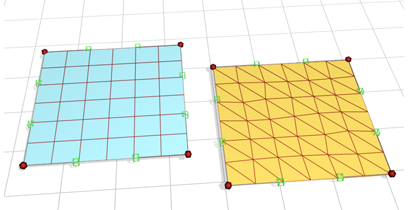You can create two kinds of patch surfaces in grid form: Quad Patch and Tri Patch. Patch grids begin as flat plane objects but can be modified into arbitrary 3D surfaces by either using an Edit Patch modifier or collapsing the grid’s modifier stack down to an Editable Patch in the Modify panel.
Patch grids provide convenient "building material" for custom surfaces and objects, or for adding patch surfaces to existing patch objects.
You can animate the surface of a Patch object using various modifiers such as the Flex and Morph modifiers. Control vertices and tangent handles of a patch surface can be animated with an Editable Patch modifier.
The output of the Surface modifier is a Patch object. Patch objects offer a flexible alternative to mesh and NURBS modeling and animation.

Quad patch and tri patch
You can convert a basic patch grid to an editable patch object. The editable patch has a variety of controls that let you directly manipulate it and its sub-objects. For example, at the Vertex sub-object level, you can move vertices or adjust their Bezier handles. Editable patches let you create surfaces that are less regular, more free-form than the basic, rectangular patches.
When you convert a patch to an editable patch, you lose the ability to adjust or animate its creation parameters.
 Create panel, activate
Create panel, activate  (Geometry). Choose Patch Grids from the drop-downlist, then on the Object Type rollout, click either Quad Patch or Tri Patch.
(Geometry). Choose Patch Grids from the drop-downlist, then on the Object Type rollout, click either Quad Patch or Tri Patch.
Quad Patch creates a flat grid with a default of 36 visible rectangular facets. A hidden line divides each facet into two triangular faces for a total of 72 faces.
Tri Patch creates a flat grid with 72 triangular faces. The face count remains at 72, regardless of its size. The faces become larger to fill the area as you increase the size of the grid.